University Contract Law Case Study Analysis and ADR Methods
VerifiedAdded on 2020/05/01
|11
|2733
|214
Homework Assignment
AI Summary
This assignment provides a comprehensive analysis of a contract law case study, delving into the intricacies of contract formation, including offer, acceptance, and consideration. It examines scenarios involving breach of contract and misrepresentation, evaluating the rights and remedies available to different parties. The analysis considers the application of legal principles to specific facts, determining whether contracts were formed and if any breaches occurred. Furthermore, the assignment explores alternative dispute resolution (ADR) methods such as arbitration, mediation, and conciliation, outlining their processes, advantages, and disadvantages. The study concludes by assessing the legal positions of each party involved, providing a clear understanding of the outcomes based on the legal principles discussed.

Commercial Law
Contract Law
(Student Details: )
Contract Law
(Student Details: )
Paraphrase This Document
Need a fresh take? Get an instant paraphrase of this document with our AI Paraphraser
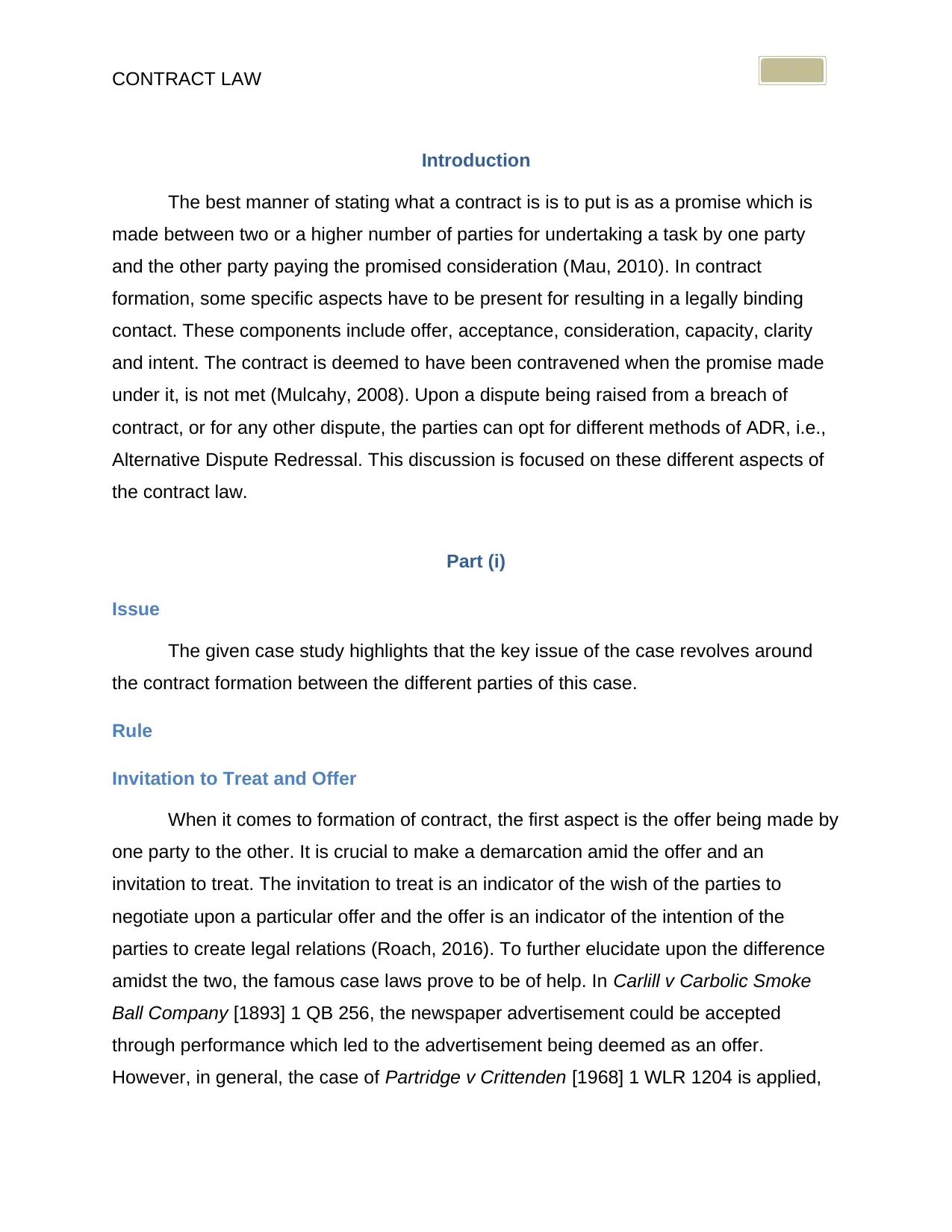
CONTRACT LAW
Introduction
The best manner of stating what a contract is is to put is as a promise which is
made between two or a higher number of parties for undertaking a task by one party
and the other party paying the promised consideration (Mau, 2010). In contract
formation, some specific aspects have to be present for resulting in a legally binding
contact. These components include offer, acceptance, consideration, capacity, clarity
and intent. The contract is deemed to have been contravened when the promise made
under it, is not met (Mulcahy, 2008). Upon a dispute being raised from a breach of
contract, or for any other dispute, the parties can opt for different methods of ADR, i.e.,
Alternative Dispute Redressal. This discussion is focused on these different aspects of
the contract law.
Part (i)
Issue
The given case study highlights that the key issue of the case revolves around
the contract formation between the different parties of this case.
Rule
Invitation to Treat and Offer
When it comes to formation of contract, the first aspect is the offer being made by
one party to the other. It is crucial to make a demarcation amid the offer and an
invitation to treat. The invitation to treat is an indicator of the wish of the parties to
negotiate upon a particular offer and the offer is an indicator of the intention of the
parties to create legal relations (Roach, 2016). To further elucidate upon the difference
amidst the two, the famous case laws prove to be of help. In Carlill v Carbolic Smoke
Ball Company [1893] 1 QB 256, the newspaper advertisement could be accepted
through performance which led to the advertisement being deemed as an offer.
However, in general, the case of Partridge v Crittenden [1968] 1 WLR 1204 is applied,
Introduction
The best manner of stating what a contract is is to put is as a promise which is
made between two or a higher number of parties for undertaking a task by one party
and the other party paying the promised consideration (Mau, 2010). In contract
formation, some specific aspects have to be present for resulting in a legally binding
contact. These components include offer, acceptance, consideration, capacity, clarity
and intent. The contract is deemed to have been contravened when the promise made
under it, is not met (Mulcahy, 2008). Upon a dispute being raised from a breach of
contract, or for any other dispute, the parties can opt for different methods of ADR, i.e.,
Alternative Dispute Redressal. This discussion is focused on these different aspects of
the contract law.
Part (i)
Issue
The given case study highlights that the key issue of the case revolves around
the contract formation between the different parties of this case.
Rule
Invitation to Treat and Offer
When it comes to formation of contract, the first aspect is the offer being made by
one party to the other. It is crucial to make a demarcation amid the offer and an
invitation to treat. The invitation to treat is an indicator of the wish of the parties to
negotiate upon a particular offer and the offer is an indicator of the intention of the
parties to create legal relations (Roach, 2016). To further elucidate upon the difference
amidst the two, the famous case laws prove to be of help. In Carlill v Carbolic Smoke
Ball Company [1893] 1 QB 256, the newspaper advertisement could be accepted
through performance which led to the advertisement being deemed as an offer.
However, in general, the case of Partridge v Crittenden [1968] 1 WLR 1204 is applied,

CONTRACT LAW
where it was held that the newspaper advertisements are an invitation to treat (Latimer,
2012).
Acceptance
Upon an offer being made by the offering party, the party to which the offer had
been made had to be accepted. It is of utmost significance that the offer which has been
made is accepted in the manner in which it made. In case of any changes in the offer,
the acceptance is not attained and instead, a counter offer is created. And as per Hyde
v. Wrench (1840) 3 Beav 334, the original offer expires with the counter offer (Marson &
Ferris, 2015). Felthouse v Bindley (1862) EWHC CP J35 provides that mere silence
cannot be deemed as acceptance (Andrews, 2015).
Another important part in acceptance is the date on which the offer is accepted
and in general, it is deemed as such a date on which the acceptance reaches the offer
making party. However, the postal rules of acceptance are a major exception to this rule
whereby the date of acceptance is such date on which the accepting party posts the
acceptance letter (McKendrick, 2014). The reason for this is that the postal office is
offering party’s agent and owing to the agency law, the acceptance of agent is the
acceptance of the principal. And in case of postal rules, the date of actual receipt of
acceptance letter by offering party does not matter. Holding the acceptance being
present, due to these rules, in Adams v. Lindsell (1818) 106 ER 250, a contract was
deemed to have been construed (Gibson & Fraser, 2013).
Consideration
The next requirement in contract formation relates to a valid consideration being
present in a contract. The consideration is deemed as valid till the time it has an
economic value (Treitel & Peel, 2015). Chappel & Co Ltd v Nestle Co Ltd [1960] AC 87
was one of such cases where the context of the case was analysed to hold if the
consideration was a valid one. And due to the condition precedent, the court accepted
the three wrappers as valid consideration (E-Law Resources, 2017).
where it was held that the newspaper advertisements are an invitation to treat (Latimer,
2012).
Acceptance
Upon an offer being made by the offering party, the party to which the offer had
been made had to be accepted. It is of utmost significance that the offer which has been
made is accepted in the manner in which it made. In case of any changes in the offer,
the acceptance is not attained and instead, a counter offer is created. And as per Hyde
v. Wrench (1840) 3 Beav 334, the original offer expires with the counter offer (Marson &
Ferris, 2015). Felthouse v Bindley (1862) EWHC CP J35 provides that mere silence
cannot be deemed as acceptance (Andrews, 2015).
Another important part in acceptance is the date on which the offer is accepted
and in general, it is deemed as such a date on which the acceptance reaches the offer
making party. However, the postal rules of acceptance are a major exception to this rule
whereby the date of acceptance is such date on which the accepting party posts the
acceptance letter (McKendrick, 2014). The reason for this is that the postal office is
offering party’s agent and owing to the agency law, the acceptance of agent is the
acceptance of the principal. And in case of postal rules, the date of actual receipt of
acceptance letter by offering party does not matter. Holding the acceptance being
present, due to these rules, in Adams v. Lindsell (1818) 106 ER 250, a contract was
deemed to have been construed (Gibson & Fraser, 2013).
Consideration
The next requirement in contract formation relates to a valid consideration being
present in a contract. The consideration is deemed as valid till the time it has an
economic value (Treitel & Peel, 2015). Chappel & Co Ltd v Nestle Co Ltd [1960] AC 87
was one of such cases where the context of the case was analysed to hold if the
consideration was a valid one. And due to the condition precedent, the court accepted
the three wrappers as valid consideration (E-Law Resources, 2017).
⊘ This is a preview!⊘
Do you want full access?
Subscribe today to unlock all pages.

Trusted by 1+ million students worldwide
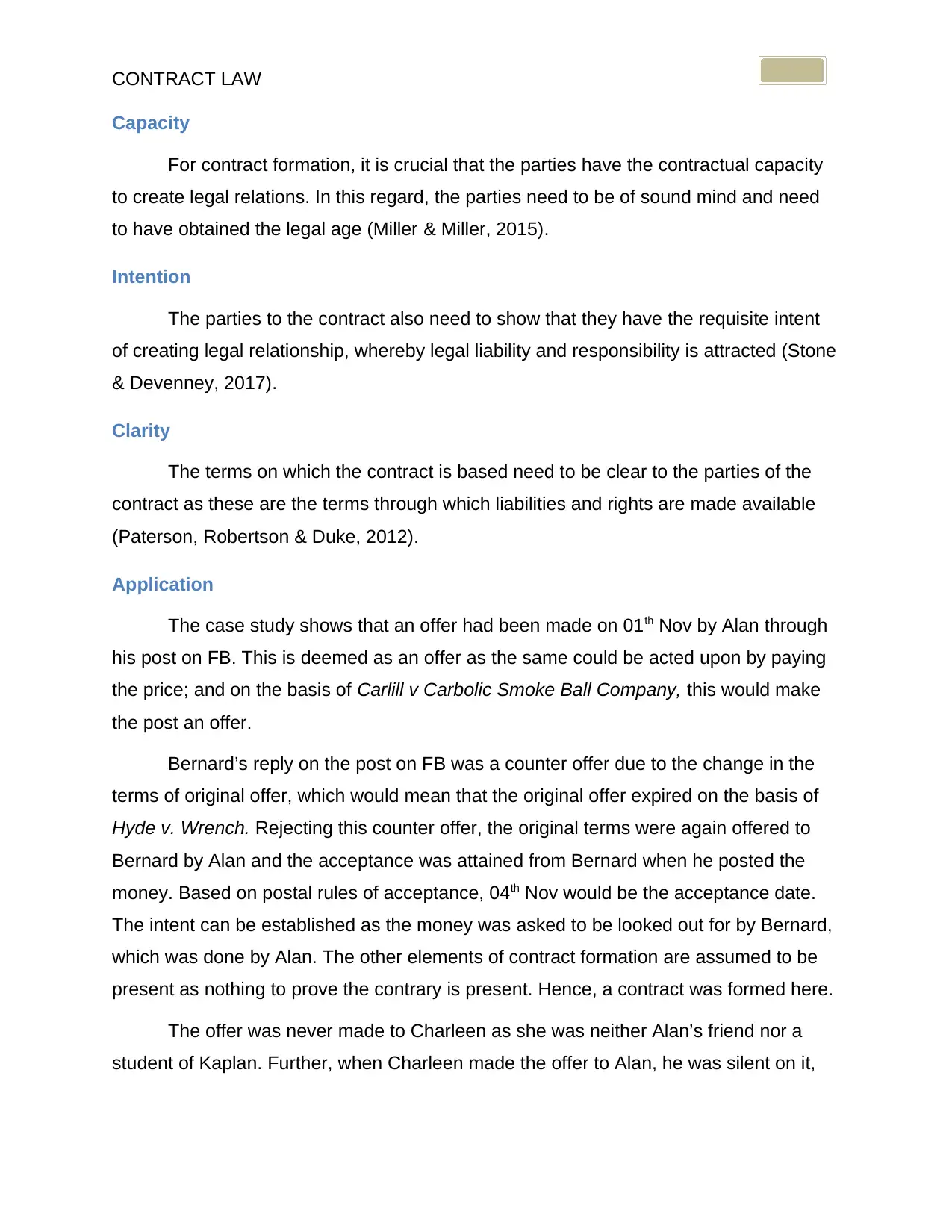
CONTRACT LAW
Capacity
For contract formation, it is crucial that the parties have the contractual capacity
to create legal relations. In this regard, the parties need to be of sound mind and need
to have obtained the legal age (Miller & Miller, 2015).
Intention
The parties to the contract also need to show that they have the requisite intent
of creating legal relationship, whereby legal liability and responsibility is attracted (Stone
& Devenney, 2017).
Clarity
The terms on which the contract is based need to be clear to the parties of the
contract as these are the terms through which liabilities and rights are made available
(Paterson, Robertson & Duke, 2012).
Application
The case study shows that an offer had been made on 01th Nov by Alan through
his post on FB. This is deemed as an offer as the same could be acted upon by paying
the price; and on the basis of Carlill v Carbolic Smoke Ball Company, this would make
the post an offer.
Bernard’s reply on the post on FB was a counter offer due to the change in the
terms of original offer, which would mean that the original offer expired on the basis of
Hyde v. Wrench. Rejecting this counter offer, the original terms were again offered to
Bernard by Alan and the acceptance was attained from Bernard when he posted the
money. Based on postal rules of acceptance, 04th Nov would be the acceptance date.
The intent can be established as the money was asked to be looked out for by Bernard,
which was done by Alan. The other elements of contract formation are assumed to be
present as nothing to prove the contrary is present. Hence, a contract was formed here.
The offer was never made to Charleen as she was neither Alan’s friend nor a
student of Kaplan. Further, when Charleen made the offer to Alan, he was silent on it,
Capacity
For contract formation, it is crucial that the parties have the contractual capacity
to create legal relations. In this regard, the parties need to be of sound mind and need
to have obtained the legal age (Miller & Miller, 2015).
Intention
The parties to the contract also need to show that they have the requisite intent
of creating legal relationship, whereby legal liability and responsibility is attracted (Stone
& Devenney, 2017).
Clarity
The terms on which the contract is based need to be clear to the parties of the
contract as these are the terms through which liabilities and rights are made available
(Paterson, Robertson & Duke, 2012).
Application
The case study shows that an offer had been made on 01th Nov by Alan through
his post on FB. This is deemed as an offer as the same could be acted upon by paying
the price; and on the basis of Carlill v Carbolic Smoke Ball Company, this would make
the post an offer.
Bernard’s reply on the post on FB was a counter offer due to the change in the
terms of original offer, which would mean that the original offer expired on the basis of
Hyde v. Wrench. Rejecting this counter offer, the original terms were again offered to
Bernard by Alan and the acceptance was attained from Bernard when he posted the
money. Based on postal rules of acceptance, 04th Nov would be the acceptance date.
The intent can be established as the money was asked to be looked out for by Bernard,
which was done by Alan. The other elements of contract formation are assumed to be
present as nothing to prove the contrary is present. Hence, a contract was formed here.
The offer was never made to Charleen as she was neither Alan’s friend nor a
student of Kaplan. Further, when Charleen made the offer to Alan, he was silent on it,
Paraphrase This Document
Need a fresh take? Get an instant paraphrase of this document with our AI Paraphraser

CONTRACT LAW
which based on Felthouse v Bindley would show that an acceptance was not attained.
Hence, a contract was not created in this case.
The offer was made to Damien since he was a student of Kaplan. The offer was
accepted by Damien by handing over the cash to Alan. The date of acceptance is 04th
Nov evening, which was after the offer of Bernard had been accepted. But, still a
contract was created here.
Conclusion
In short, the contracts were created between Alan-Bernard and Alan-Damien and
not between Alan-Charleen.
Part (ii)
Issue
The given case study highlights that the key issue of the case revolves around
the available rights with Bernard against Alan.
Rule
Breach of Contract
When the promise made under the contract is not fulfilled, it results in the
contract being breached. Upon a breach of contract, the compliant party gets the option
of claiming equitable damages, in terms of specific performance or injunction, or opt for
monetary compensation (Latimer, 2012).
Misrepresentation
During the negotiations of the contract, when false statements are made to
induce the party in going forward with the contract, it is considered as
misrepresentation. When such happens, the compliant party has the option of
rescinding the contract due to the contracts formed with misrepresentation being
voidable in nature (Latimer, 2012).
which based on Felthouse v Bindley would show that an acceptance was not attained.
Hence, a contract was not created in this case.
The offer was made to Damien since he was a student of Kaplan. The offer was
accepted by Damien by handing over the cash to Alan. The date of acceptance is 04th
Nov evening, which was after the offer of Bernard had been accepted. But, still a
contract was created here.
Conclusion
In short, the contracts were created between Alan-Bernard and Alan-Damien and
not between Alan-Charleen.
Part (ii)
Issue
The given case study highlights that the key issue of the case revolves around
the available rights with Bernard against Alan.
Rule
Breach of Contract
When the promise made under the contract is not fulfilled, it results in the
contract being breached. Upon a breach of contract, the compliant party gets the option
of claiming equitable damages, in terms of specific performance or injunction, or opt for
monetary compensation (Latimer, 2012).
Misrepresentation
During the negotiations of the contract, when false statements are made to
induce the party in going forward with the contract, it is considered as
misrepresentation. When such happens, the compliant party has the option of
rescinding the contract due to the contracts formed with misrepresentation being
voidable in nature (Latimer, 2012).
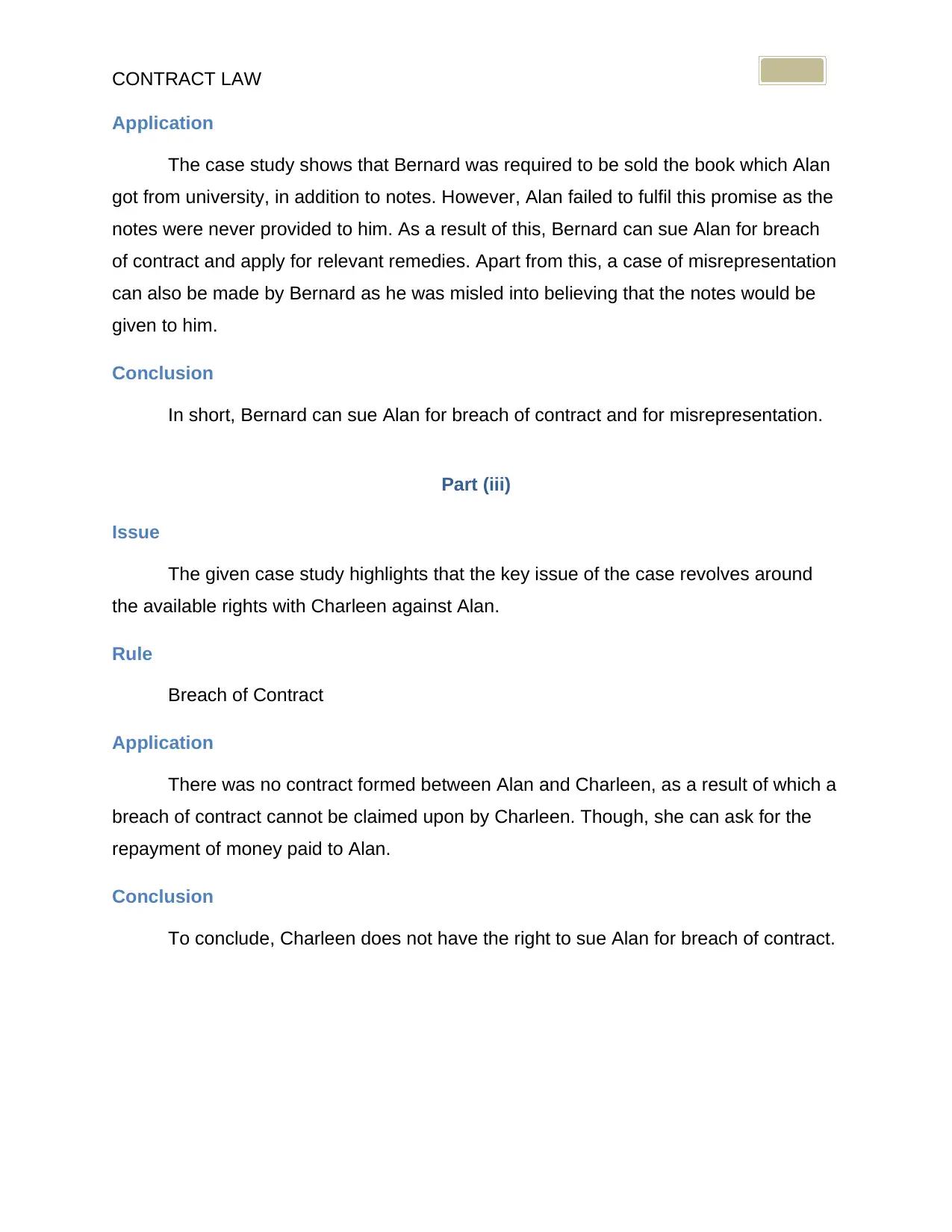
CONTRACT LAW
Application
The case study shows that Bernard was required to be sold the book which Alan
got from university, in addition to notes. However, Alan failed to fulfil this promise as the
notes were never provided to him. As a result of this, Bernard can sue Alan for breach
of contract and apply for relevant remedies. Apart from this, a case of misrepresentation
can also be made by Bernard as he was misled into believing that the notes would be
given to him.
Conclusion
In short, Bernard can sue Alan for breach of contract and for misrepresentation.
Part (iii)
Issue
The given case study highlights that the key issue of the case revolves around
the available rights with Charleen against Alan.
Rule
Breach of Contract
Application
There was no contract formed between Alan and Charleen, as a result of which a
breach of contract cannot be claimed upon by Charleen. Though, she can ask for the
repayment of money paid to Alan.
Conclusion
To conclude, Charleen does not have the right to sue Alan for breach of contract.
Application
The case study shows that Bernard was required to be sold the book which Alan
got from university, in addition to notes. However, Alan failed to fulfil this promise as the
notes were never provided to him. As a result of this, Bernard can sue Alan for breach
of contract and apply for relevant remedies. Apart from this, a case of misrepresentation
can also be made by Bernard as he was misled into believing that the notes would be
given to him.
Conclusion
In short, Bernard can sue Alan for breach of contract and for misrepresentation.
Part (iii)
Issue
The given case study highlights that the key issue of the case revolves around
the available rights with Charleen against Alan.
Rule
Breach of Contract
Application
There was no contract formed between Alan and Charleen, as a result of which a
breach of contract cannot be claimed upon by Charleen. Though, she can ask for the
repayment of money paid to Alan.
Conclusion
To conclude, Charleen does not have the right to sue Alan for breach of contract.
⊘ This is a preview!⊘
Do you want full access?
Subscribe today to unlock all pages.

Trusted by 1+ million students worldwide
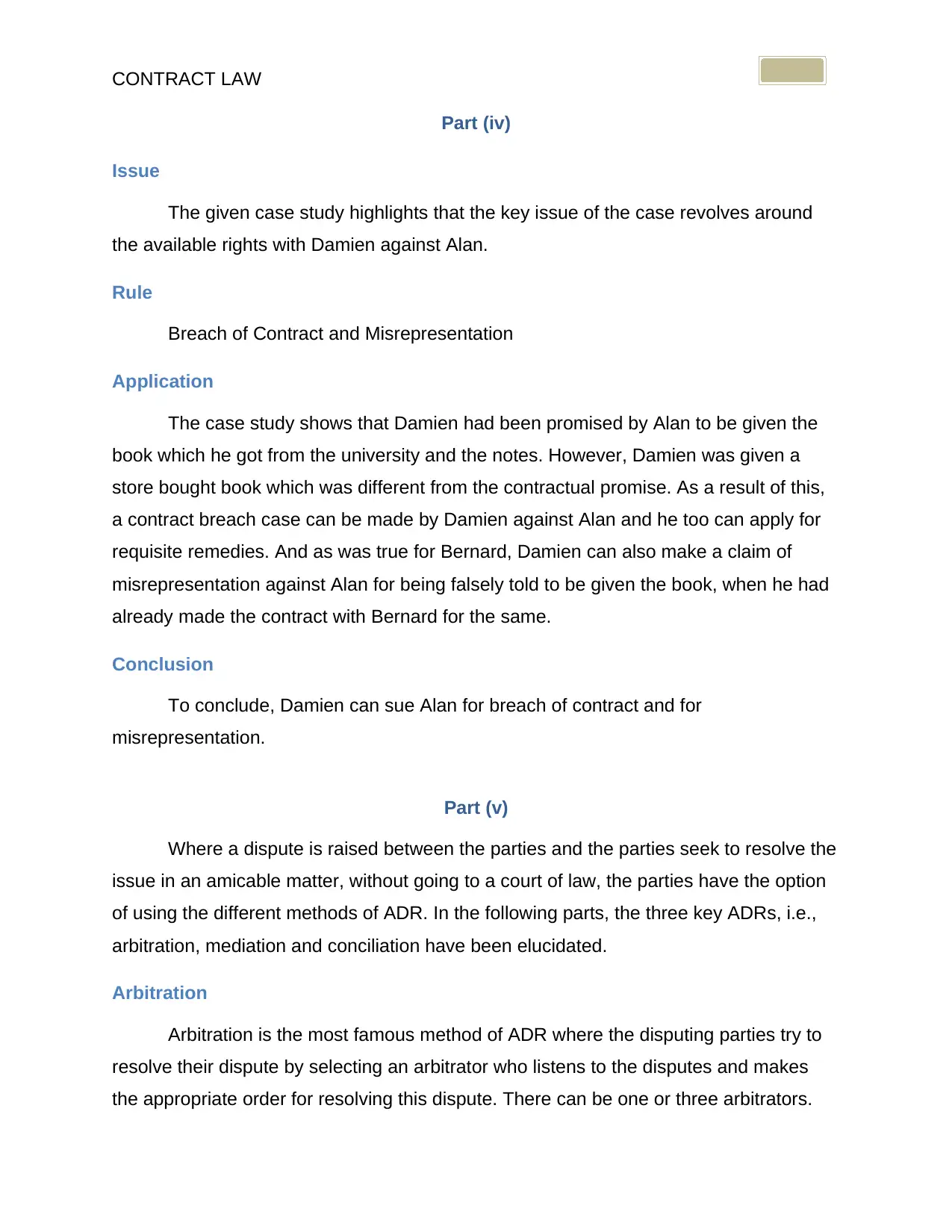
CONTRACT LAW
Part (iv)
Issue
The given case study highlights that the key issue of the case revolves around
the available rights with Damien against Alan.
Rule
Breach of Contract and Misrepresentation
Application
The case study shows that Damien had been promised by Alan to be given the
book which he got from the university and the notes. However, Damien was given a
store bought book which was different from the contractual promise. As a result of this,
a contract breach case can be made by Damien against Alan and he too can apply for
requisite remedies. And as was true for Bernard, Damien can also make a claim of
misrepresentation against Alan for being falsely told to be given the book, when he had
already made the contract with Bernard for the same.
Conclusion
To conclude, Damien can sue Alan for breach of contract and for
misrepresentation.
Part (v)
Where a dispute is raised between the parties and the parties seek to resolve the
issue in an amicable matter, without going to a court of law, the parties have the option
of using the different methods of ADR. In the following parts, the three key ADRs, i.e.,
arbitration, mediation and conciliation have been elucidated.
Arbitration
Arbitration is the most famous method of ADR where the disputing parties try to
resolve their dispute by selecting an arbitrator who listens to the disputes and makes
the appropriate order for resolving this dispute. There can be one or three arbitrators.
Part (iv)
Issue
The given case study highlights that the key issue of the case revolves around
the available rights with Damien against Alan.
Rule
Breach of Contract and Misrepresentation
Application
The case study shows that Damien had been promised by Alan to be given the
book which he got from the university and the notes. However, Damien was given a
store bought book which was different from the contractual promise. As a result of this,
a contract breach case can be made by Damien against Alan and he too can apply for
requisite remedies. And as was true for Bernard, Damien can also make a claim of
misrepresentation against Alan for being falsely told to be given the book, when he had
already made the contract with Bernard for the same.
Conclusion
To conclude, Damien can sue Alan for breach of contract and for
misrepresentation.
Part (v)
Where a dispute is raised between the parties and the parties seek to resolve the
issue in an amicable matter, without going to a court of law, the parties have the option
of using the different methods of ADR. In the following parts, the three key ADRs, i.e.,
arbitration, mediation and conciliation have been elucidated.
Arbitration
Arbitration is the most famous method of ADR where the disputing parties try to
resolve their dispute by selecting an arbitrator who listens to the disputes and makes
the appropriate order for resolving this dispute. There can be one or three arbitrators.
Paraphrase This Document
Need a fresh take? Get an instant paraphrase of this document with our AI Paraphraser

CONTRACT LAW
When the parties are unable to choose a common arbitrator, they can choose one
arbitrator each and these two arbitrators than choose the final arbitrator. This, an
arbitrator is selected to preside over the disputed issue. This method has various
benefits and drawbacks. Arbitration is a cheaper method in comparison to litigation
method. And the arbitration award applies over the parties. Though, till the same is
backed by the court order, the same cannot be enforced in a strict manner. Once the
same is affirmed by the court of law, the arbitration award becomes binding in nature
(Fiadjoe, 2013).
Conciliation
Another leading method of ADR is conciliation in which a common conciliator is
selected, who meets with the disputing parties in a separate manner and then tries to
solve the disputed issue. This method too is marked with different benefits and
demerits. The parties in conciliation method can suggest the possible solutions to the
dispute at hand and also have the choice of approving a specified solution. The
relationship between the parties is less likely to be damaged in comparison to litigation
as the matter is resolved amicably with approval of parties. The conciliation matters are
private and confidential, which is not possible in litigation method. The drawback
includes the refusal of the parties to adopt a particular solution, where it does not favour
them, thus creating barriers in attaining a mutual agreement. Also, the matters can be
worsened due to lack of legal advisors (Fiadjoe, 2013).
Mediation
In this method, a mediator is selected for resolving the disputed issue by listening
to each side’s contentions and attempting to resolve the issue by adopting different
techniques of negotiations. Hence, an attempt is to “mediate” the dispute. The matters
remain private and confidential and the control over the mediation results is maintained
by the mediator, which helps in obtaining fair and unbiased results. This is again a cost
effective method (Nolan-Haley, 2013).
This method, like any other method of ADR, is backed with different
disadvantages. The order given by the mediator is not binding upon the disputing
When the parties are unable to choose a common arbitrator, they can choose one
arbitrator each and these two arbitrators than choose the final arbitrator. This, an
arbitrator is selected to preside over the disputed issue. This method has various
benefits and drawbacks. Arbitration is a cheaper method in comparison to litigation
method. And the arbitration award applies over the parties. Though, till the same is
backed by the court order, the same cannot be enforced in a strict manner. Once the
same is affirmed by the court of law, the arbitration award becomes binding in nature
(Fiadjoe, 2013).
Conciliation
Another leading method of ADR is conciliation in which a common conciliator is
selected, who meets with the disputing parties in a separate manner and then tries to
solve the disputed issue. This method too is marked with different benefits and
demerits. The parties in conciliation method can suggest the possible solutions to the
dispute at hand and also have the choice of approving a specified solution. The
relationship between the parties is less likely to be damaged in comparison to litigation
as the matter is resolved amicably with approval of parties. The conciliation matters are
private and confidential, which is not possible in litigation method. The drawback
includes the refusal of the parties to adopt a particular solution, where it does not favour
them, thus creating barriers in attaining a mutual agreement. Also, the matters can be
worsened due to lack of legal advisors (Fiadjoe, 2013).
Mediation
In this method, a mediator is selected for resolving the disputed issue by listening
to each side’s contentions and attempting to resolve the issue by adopting different
techniques of negotiations. Hence, an attempt is to “mediate” the dispute. The matters
remain private and confidential and the control over the mediation results is maintained
by the mediator, which helps in obtaining fair and unbiased results. This is again a cost
effective method (Nolan-Haley, 2013).
This method, like any other method of ADR, is backed with different
disadvantages. The order given by the mediator is not binding upon the disputing
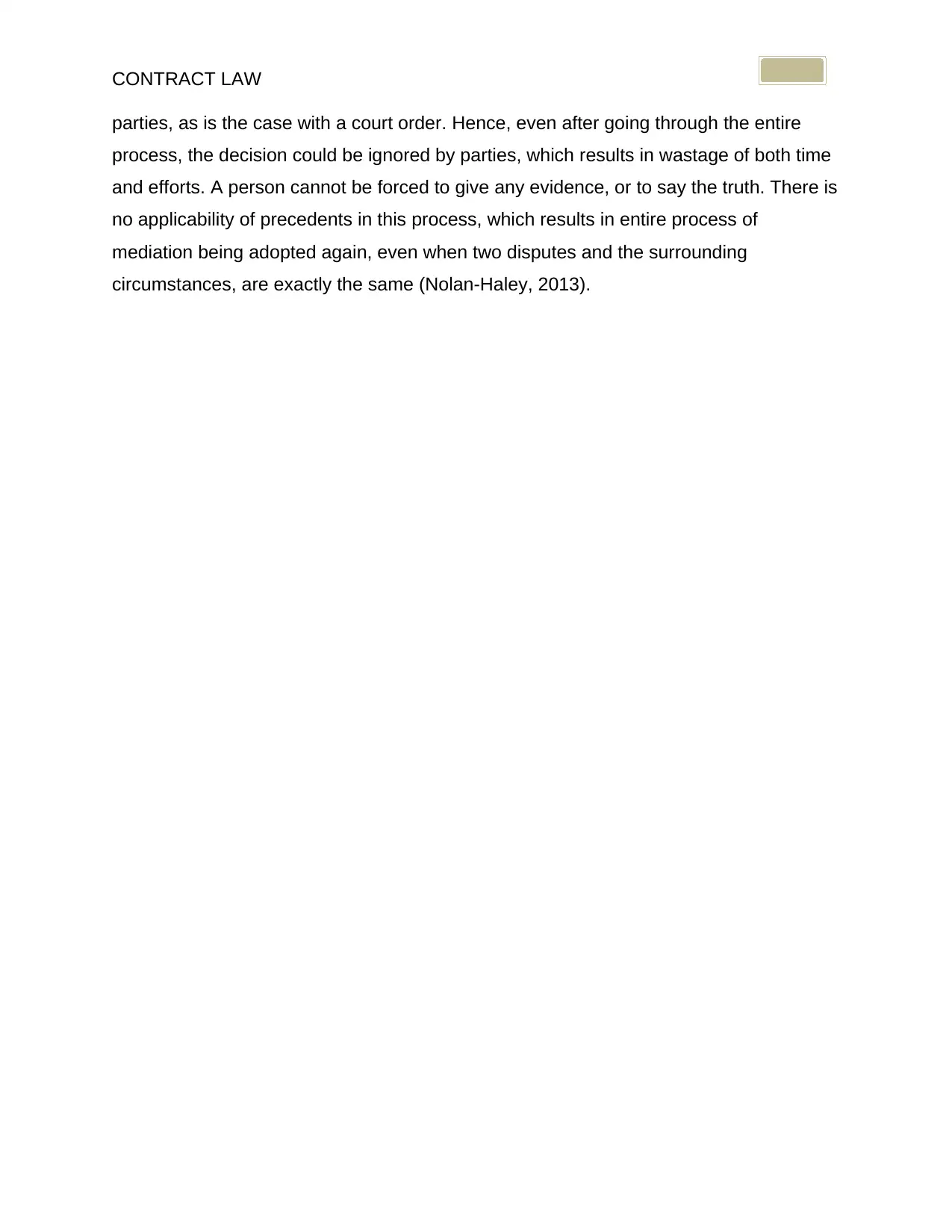
CONTRACT LAW
parties, as is the case with a court order. Hence, even after going through the entire
process, the decision could be ignored by parties, which results in wastage of both time
and efforts. A person cannot be forced to give any evidence, or to say the truth. There is
no applicability of precedents in this process, which results in entire process of
mediation being adopted again, even when two disputes and the surrounding
circumstances, are exactly the same (Nolan-Haley, 2013).
parties, as is the case with a court order. Hence, even after going through the entire
process, the decision could be ignored by parties, which results in wastage of both time
and efforts. A person cannot be forced to give any evidence, or to say the truth. There is
no applicability of precedents in this process, which results in entire process of
mediation being adopted again, even when two disputes and the surrounding
circumstances, are exactly the same (Nolan-Haley, 2013).
⊘ This is a preview!⊘
Do you want full access?
Subscribe today to unlock all pages.

Trusted by 1+ million students worldwide
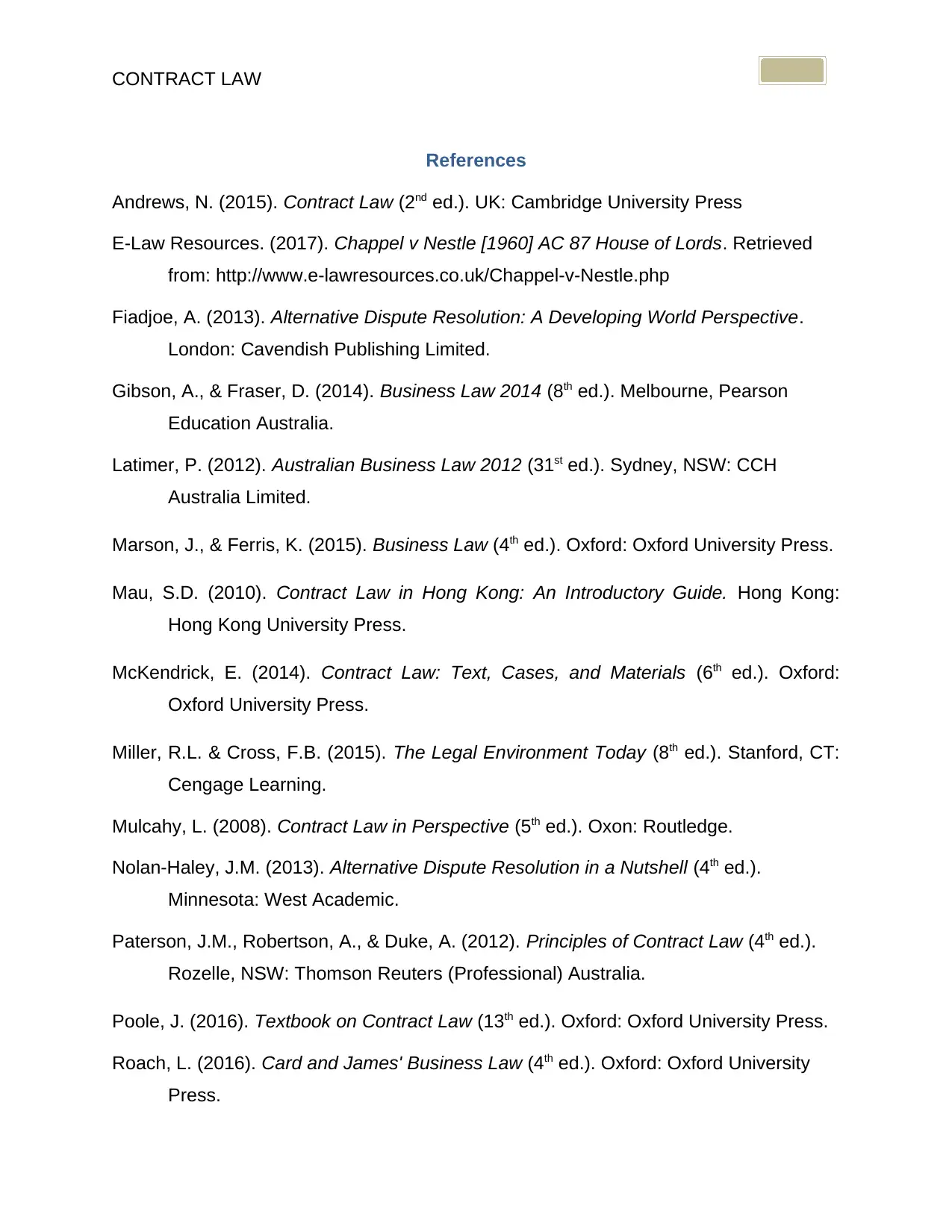
CONTRACT LAW
References
Andrews, N. (2015). Contract Law (2nd ed.). UK: Cambridge University Press
E-Law Resources. (2017). Chappel v Nestle [1960] AC 87 House of Lords. Retrieved
from: http://www.e-lawresources.co.uk/Chappel-v-Nestle.php
Fiadjoe, A. (2013). Alternative Dispute Resolution: A Developing World Perspective.
London: Cavendish Publishing Limited.
Gibson, A., & Fraser, D. (2014). Business Law 2014 (8th ed.). Melbourne, Pearson
Education Australia.
Latimer, P. (2012). Australian Business Law 2012 (31st ed.). Sydney, NSW: CCH
Australia Limited.
Marson, J., & Ferris, K. (2015). Business Law (4th ed.). Oxford: Oxford University Press.
Mau, S.D. (2010). Contract Law in Hong Kong: An Introductory Guide. Hong Kong:
Hong Kong University Press.
McKendrick, E. (2014). Contract Law: Text, Cases, and Materials (6th ed.). Oxford:
Oxford University Press.
Miller, R.L. & Cross, F.B. (2015). The Legal Environment Today (8th ed.). Stanford, CT:
Cengage Learning.
Mulcahy, L. (2008). Contract Law in Perspective (5th ed.). Oxon: Routledge.
Nolan-Haley, J.M. (2013). Alternative Dispute Resolution in a Nutshell (4th ed.).
Minnesota: West Academic.
Paterson, J.M., Robertson, A., & Duke, A. (2012). Principles of Contract Law (4th ed.).
Rozelle, NSW: Thomson Reuters (Professional) Australia.
Poole, J. (2016). Textbook on Contract Law (13th ed.). Oxford: Oxford University Press.
Roach, L. (2016). Card and James' Business Law (4th ed.). Oxford: Oxford University
Press.
References
Andrews, N. (2015). Contract Law (2nd ed.). UK: Cambridge University Press
E-Law Resources. (2017). Chappel v Nestle [1960] AC 87 House of Lords. Retrieved
from: http://www.e-lawresources.co.uk/Chappel-v-Nestle.php
Fiadjoe, A. (2013). Alternative Dispute Resolution: A Developing World Perspective.
London: Cavendish Publishing Limited.
Gibson, A., & Fraser, D. (2014). Business Law 2014 (8th ed.). Melbourne, Pearson
Education Australia.
Latimer, P. (2012). Australian Business Law 2012 (31st ed.). Sydney, NSW: CCH
Australia Limited.
Marson, J., & Ferris, K. (2015). Business Law (4th ed.). Oxford: Oxford University Press.
Mau, S.D. (2010). Contract Law in Hong Kong: An Introductory Guide. Hong Kong:
Hong Kong University Press.
McKendrick, E. (2014). Contract Law: Text, Cases, and Materials (6th ed.). Oxford:
Oxford University Press.
Miller, R.L. & Cross, F.B. (2015). The Legal Environment Today (8th ed.). Stanford, CT:
Cengage Learning.
Mulcahy, L. (2008). Contract Law in Perspective (5th ed.). Oxon: Routledge.
Nolan-Haley, J.M. (2013). Alternative Dispute Resolution in a Nutshell (4th ed.).
Minnesota: West Academic.
Paterson, J.M., Robertson, A., & Duke, A. (2012). Principles of Contract Law (4th ed.).
Rozelle, NSW: Thomson Reuters (Professional) Australia.
Poole, J. (2016). Textbook on Contract Law (13th ed.). Oxford: Oxford University Press.
Roach, L. (2016). Card and James' Business Law (4th ed.). Oxford: Oxford University
Press.
Paraphrase This Document
Need a fresh take? Get an instant paraphrase of this document with our AI Paraphraser

CONTRACT LAW
Stone, R., & Devenney, J. (2017). The Modern Law of Contract (12th ed.). Oxon:
Routledge.
Treitel, G H., & Peel, E. (2015). The Law of Contract (14th ed.). London: Sweet and
Maxwell.
Stone, R., & Devenney, J. (2017). The Modern Law of Contract (12th ed.). Oxon:
Routledge.
Treitel, G H., & Peel, E. (2015). The Law of Contract (14th ed.). London: Sweet and
Maxwell.
1 out of 11
Related Documents
Your All-in-One AI-Powered Toolkit for Academic Success.
+13062052269
info@desklib.com
Available 24*7 on WhatsApp / Email
![[object Object]](/_next/static/media/star-bottom.7253800d.svg)
Unlock your academic potential
Copyright © 2020–2025 A2Z Services. All Rights Reserved. Developed and managed by ZUCOL.





